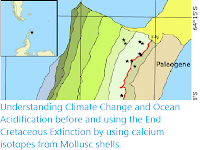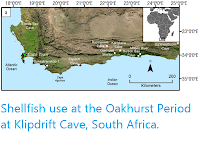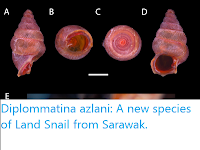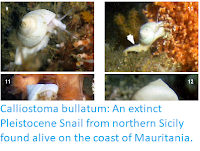Although Mollusca is, after Arthropoda, the second-most species-rich animal phylum on land (at least in terms of described species), their species numbers are only moderately high compared with the Arthropods. Even in hyperdiverse forested regions in the humid tropics, such as northern Borneo, the numbers of known species are in the hundreds, not thousands and trends of discovery appear to be levelling off towards the true number of species. This means that, with relatively little fieldwork effort, it is possible to obtain a more or less complete inventory of the terrestrial malacofauna of a certain area.
In a paper published in the Biodiversity Data Journal on 20 February 2020, a team of taxonomic experts and lay people led by Menno Schilthuizen of Taxon Expeditions, the Naturalis Biodiversity Center, Universiti Malaysia Sabah, and the Faculty of Science & Institute for Biodiversity and Environmental Research at University Brunei Darussalam, describe a new species of terrestrial Caenogastropod discovered during a citizen science project in the Kuala Belalong rainforest of Brunei Darussalam (Borneo).
Schilthuizen et al. are using field courses to several biodiversity hotspots in the world for such a purpose and they use the term 'taxon expeditions' for this. Taxon expeditions are a new concept in which a group of taxonomic experts and lay people work together in a hybrid work form of field course and biodiversity discovery expedition to discover unknown species from a given area. On their annual taxon expedition to the Ulu Temburong lowland rainforest in Brunei Darussalam, surveys of terrestrial snails have so far yielded over 25 species. The expected diversity for this type of forest would be around 85 species, but already our inventories are turning up previously unknown species.
Schilthuizen et al. describe a new species from the large Caenogastropod family Cyclophoridae. In the Southeast Asian tropics, non-Stylommatophora (i.e. Neritopsina and Caenogastropoda, not Pulmonates, the most common and familiar group of terrestrial Gastropods) comprise nearly half of the total malacofauna. These Snails are, however, more sensitive to habitat disturbance than the Stylommatophora. Studies of malacofauna conservation biology on limestone hills in Sabah have previously shown that these non-Stylommatophora groups are the first to disappear after forest degradation, presumably as a result of lower tolerance ranges for temperature and humidity.
The description of the new Cyclophorid is the concerted effort of untrained ‘citizen scientists’ working together in a field lab. The specific epithet was decided upon during a voting session, in which participants could suggest and vote for scientific names.
Schilthuizen et al. collected living snails by hand, at night, amongst vegetation along the left (south) bank of the Belalong river, 50 m downstream of Kuala Belalong Field Studies Centre. Specimens were sorted to putative morphospecies and then further examined morphologically with a dissection microscope with 10× and 20× eye pieces. Photographs and video were made either with a smartphone through the eyepiece of a microscope or on a translucent white acrylic sheet with a Nikon D800e fitted with a Laowa 25 mm ultra-macro lens. Drawings were made based on the photographs. Specimens were deposited in the collection of the University of Brunei Darussalam Museum.
The new species is placed in the genus Craspedotropis, and given the specific name gretathunbergae, in hounour of the young climate activist Greta Thunberg, because Caenogastropod Microsnails from tropical rainforests, like this new species, are very sensitive to the droughts and temperature extremes that are likely to be more frequent as climate change continues. Via mutual contacts, Schilthuizen et al. approached Ms. Thunberg and learned that she would be 'delighted' to have this species named after her.
The protoconch (the larval shell of a Snail, which forms the tip of the adult shell) lacks distinct sculpture and the juncture with the teleoconch (adult shell) not visible. The spire of the shell is highly conical, consisting of 5.25 to 5.75 convex whorls, The radial sculpture comprises growth lines and densely placed riblets (30-70 per mm on the body whorl), while the spiral sculpture comprises 4 high, prominent, here and there somewhat crenellated radial ribs, which start after 1.5 to 2.0 whorls. The first spiral rib (from the top) is located between the periphery and the suture with the previous whorl. The second sits at the periphery. The third is located near the suture with the next whorl and is visible on the body whorl in some, but not all, individuals. The fourth is located on the basal side and only visible on the edge of the umbilicus. Between the ribs are fine spiral lines. The umbilicus (gap between the whorls, seen on the underside of an upturned shell) is wide, without additional spiral ribs.
Craspedotropis gretathunbergae, shell in apertural view. Pierre Escoubas in Schilthuizen et al. (2020).
The aperture of the shell is slightly wider than high, the peristome (shell around the apature) slightly thickened, with angularities coinciding with the four spiral ribs, but without sinuosities; the basal side is horizontal. The apature is 0.86 - 0.90 mm high and 0.92 - 0.97 mm wide. The peristome carries about 10 tightly packed accretions, coloured dark brown because of the thickened periostracum (thin organic coating or 'skin' of the shell).
Craspedotropis gretathunbergae. (a) Shell with operculum in apertural view. (b) Detail of the body whorl in lateral view. (c) Detail of the shell in umbilical view. Schilthuizen et al. (2020).
The operculum ('lid' used to seal the shell) is thin and horn-like. The whorl margins not raised but flattened into a smooth concave dish, of which the outer part is greenish-brown (presumably because of a thickly applied periostracum), the central part nearly clear. No calcareous matter visible.
The species is known only from the Ulu Temburong lowland rainforest of Temburong District in Brunei Darussalam. It is found in tropical mixed Dipterocarp lowland rainforest. All individuals were found alive at the foot of a steep hill-slope, next to a river bank, foraging at night on the upper surfaces of green leaves of understorey plants, up to 1 m above ground level.
Active individual of Craspedotropis gretathunbergae. Pierre Escoubas in Schilthuizen et al. (2020).
See also...
Follow Sciency Thoughts on Facebook.








